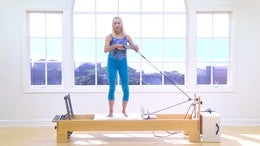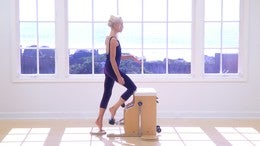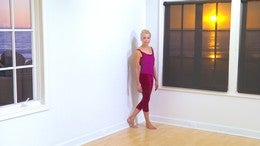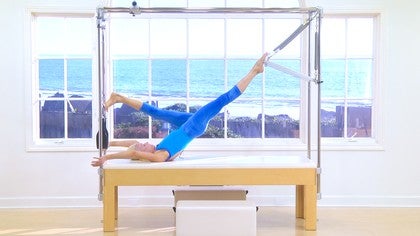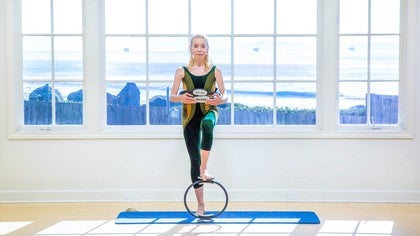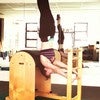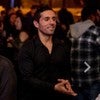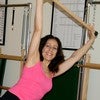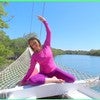Description
About This Video
Transcript
Read Full Transcript
Welcome to [inaudible] anytime. I'm Elizabeth Larkin and I'm so happy to be back with you this time. I'm going to focus on a trade program for the trapeze table and this takes inspiration from a recent book by hand, Spring Publishing. The editor is Robert Schleifer and the title of the book is Fascia in Sport and movement. You can reference this book and other books that I've recommended as a reference list to support your further study by taking a look at the [inaudible] anytime a websites. Let's talk about the setup of the trapeze table first.
As you can see, we have a couple of long boxes arranged here and this is a stability sling, happens to be a balanced body stability sling that's attached by two long purple springs to the slider, the crossbar slider. Uh, you can see that I've used a couple of extra carabiners here. When you arrange the stability sling, it's here to support your head and your neck and it's important that your head and neck be in neutral. Uh, for some people they'll be fine. With the yellow springs. I found that the purple springs with the Caribbean ers were just right. Using a rotator disk is optional.
We'll use it for one of the exercises and you can see here that, um, on the push through bar, I've used some smaller carabiners to attach a couple of handles so that the handles can swivel. When your hands are on the push through bar, uh, you're limited in the, uh, rotation through your upper body and your shoulder girdle. This will be easier. Now, just in case you don't happen to have a stability sling in your treasure chest, don't worry, you can make your own. Take a couple of foot loops, connect them via a carabiner, and then fold a non-skid mat and put it, uh, under the care beaner so that you can make a harness for your head. All right. Now that we finished that crafts project, we're going to put this down and get ready to climb a board climbing up here, slide down onto the box and position yourself so that the stability sling is cradling your head, cradling the back of your head as if you had a hammock for the back of your brain. Now the springs ought to be perpendicular to the ground and when you are supported by the springs, your head and your neck, your cervical spine will be in neutral. You could have your knees bent, the soles of your feet in contact with the box that will throw more weight towards the back of your head, or you could have your legs out stretched your inner ankle bones and your big toe joints and your inner knees aiming towards each other. You have options for your hands, your arms. They can be here, your hands resting on your pounders, or you can have your hands pressed into the uprights. In this case, you can use the ground force through the heels of your hands to remind yourself for scapular depression and to remind yourself further of the connections of the Anterior Oblique sling system, sliding your ribs in the direction of your pelvis.
The last arm variation would be to have your hands up off your head like this. This more advanced position makes more demands on the upper obliques and the intercostals anchoring your hands here. As you exhale, lengthen the back of your neck and glide your face away from the ceiling. Exhaling as you length from the back of your neck. Press the heels of your hands into the uprights and remind yourself to keep the connection of ribs to pelvis and the collar bones wide.
Next variation is a slight tilt, tilting your head on your neck as if to bring your right ear to listen towards your right shoulder and your left ear to listen towards your left shoulder. Now when your left ear listens to your left shoulder, increase the pressure of the heel of your right hand onto the bar. That will help to stabilize your shoulder girdle. Because remember, this is a, uh, cervical, a slight motion of the cervical spine. It's not for the thoracic spine at this moment. Do this.
Keeping your nose and your gaze directly forward to the ceiling. Eventually you can let your eyes be the advanced team of the spine by moving your eyes down into the left. You'll encourage left side bending of the cervical spine by moving your eyes down into the right. You'll encourage right side bending.
This is a lateral translation, lengthening the right side of your neck. Your right ear listens past your right elbow. Come to center as you inhale. Lengthen the left side of your neck. Now as you shift your, uh, cervical spine and your head to the right, reach long with your left heel and anchor the heel of your left hand. Inhale, translate to the left.
Press your right hand and your right heel. Inhale to s, uh, laterally. Translate. Exhale, center, keeping your arm pits fairly steady as your head translates. The next variation is rotation, lengthening back of your neck, turning the back of your brain, the right hemisphere of your brain to the left. Rotate nose to the right and come center. Turning the back of your left brain to the right. Your nose turns to the left.
Exhale a long gate and rotate. When you rotate to the right press through the heel of your left hand. And when you rotate to the Left, press to the heel of your right hand and no doubt you'll notice the activity of the upper obliques and the intercostals as you rotate around your central axis. And next, it's as if your head was on a small saucer at the top of your cervical spine. Translate to the left, Elongate to the floor, translate to the right and towards the ceiling.
Exhale towards the floor. Inhale towards the ceiling. Keep the rotation out of it so that your nose is aiming directly towards the ceiling. When you finish with these variations, you could have an active rest. Interlace your fingers. Aim the palms above the top of your head, your elbows wide to the side, and the sling will support your head while you activate your upper obliques and intercostals to keep the connection of your chest bone towards your pubic bone. This active rest in which your elbows are wide to the side might give some relief to the um, shoulder tension that's so prevalent in this era of laptop, neck and computer posture. [inaudible].
Now to get out of this caution slide back up and work your way back onto the box, pushing with your hands and when you get to the box so that your head is supported by the box, then you can gently remove the sling and puts your head down. Rest for a moment and feel your new self roll to your side. Now make your way up from here. Let's clear the deck and get ready for the next event in which you'll address the organization of your shoulder girdle off with these boxes. We'll just get them out of the way for now. One in front and then one in back.
Exhaling sliding your left scapula towards your right pelvis. Inhale, push, anchor and slide. Exhale to return. So this would be scapular elevation and abduction, depression and ad duction. A ground force from your right foot travels diagonally to your left hand.
Inhale, turning your pelvis to the right. Exhale, turn your pelvis to the left when it's time to come up. Duck and make your way up from here. Change now to the new side. Your right hand is on the far side of the push through bar. Come to lie on your front with a straight elbow.
The push through bar is even with the frame and your forehead. The center of your forehead is on the back
Inhale,
Inhale and the springs will encourage your torso to rotate to the left. Stand your ground with your right foot. So the light from your right kneecap goes directly towards the ceiling. Inhale, internally, rotating from your right shoulder, turning your palm, uh, towards the ocean, turning your palm to the right. Exhale to come down. Inhale, starting the ground force through the sole of your foot.
It travels your pelvis, rotating around the head of your femur and then goes up on this variation. Your eyes stay steady where the springs cross. Now in the second variation, your head, neck, and eyes turn all together with your torso. If you prefer to have a cushion or a pillow underneath your a cervical spine. So your cervical spine can be more in neutral and less of a side bending.
Feel free. Help yourself to that. Inhale, push, anchor, turn and rotate on the way down. Draw your right shoulder down home to the carriage. That's the table, isn't it? We left the reformer some time ago and now on the trapeze table case I didn't notice. So that's three. That's two variations with the turning of your thoracic spine.
Now the third variation, your head, neck and eyes will turn opposite the direction in which your pelvis is turning. Anchor your right foot, turning your pelvis to the left is before your head. Neck and eyes turn slightly to the right. All the while keeping your right knee cap shining directly at the ceiling. Lots of opportunity to practice assisted internal rotation and resisted external rotation. Slide.
Make a change with your feet now bending your left knee. Your left heel is in line with your left sitting bone and your left hand reaches across aiming your nose and your head, neck and eyes. Your pelvis is assisted in turning to the right and returning to the mat is resisted. Inhaling, internally rotate. Exhaling external rotation to come down to more of these. Inhale to rotate steering your right knee cap directly towards the ceiling, pressing the sole of your left foot into the table.
Second variation your head, neck, and eyes turn in the same direction with your pelvis. Inhaling as if to expand to your left long show. Older Blade descendens push anchor and go and return. One more of these. The last variation of fees is to turn your head, neck and eyes slightly to the left when your pelvis turns to the right.
Push with your left foot. Rotate your head, neck and eyes. Look to the left. Inhale on the exhalation. Slide your shoulders down. Now Cross over the midline. Both knees are bent. As you exhale.
Aim your gaze down behind the cheekbones of your face internally. Rotate from the shoulder joint. Nod your nose downward and you get some assistance in spine fluxion come down and then some assistance in thoracic extension. Internally, rotate this way and externally rotate change so that the other hand is on top. You can either keep your knees bent or your legs could be outstretched.
Exhaling. Nod your nose down. Burt assisted row up here and assisted spine extension internally. Rotate and nod your nose downward. See behind the cheekbones of your face when you look up underneath your eyebrows and touch the tip of your tongue to the roof of your mouth behind your upper teeth. That assists spine extension. Now we'll go back to the first exercise are the one we were doing just previously and alternate sides. Push and rotate and return change.
Push and rotate and return. Chinese change. Push and go and return. Push and go and return. Time to roll up all the way. Nod your nose downward.
See behind the cheekbone stuff your face internally rotate. Roll up in the direction of sitting. Show old are blades descend, roll down, change to the other arm on top. A equal opportunity. Even though all of us are asymmetrical and it's useful to try all the different variations.
Roll right on up and we're so very done with that. Now we've worked on organizing the shoulder girdle from prone from supine times to do the similar motion in sitting for this, you'll need just one blue spring. Take off the short red one now and we will need these boxes, these long boxes for a foot rest to provide a ground force for your feet. So position the box one on one side of the table and one on the other.
Do a a distance test by holding with your left hand holding the, the s handle. That's more forward. And I'm just checking to feel that when each finger gets a turn to pull the handle down, that there is sufficient distance so that I need to initiate this with uh, with scapular depression rather than something else. Okay. It's a SIF, just the little finger side of your hand could pull the handle down starting with the palm, your left palm away from you. As you exhale, slide your left shoulder blade towards the right sitting ball and turn away from the bar and turn towards the bar. Now your left, your uh, fourth finger pulse down shoulder, desense your third finger pulse down and your second finger and then all the fingers pulling down and looking away. Now as your little finger pulls down, you look towards and then you look away pulling down, looking towards and away. And your focus will be a proximal meaning.
Your shoulder blade motion that connects to your fingers. The new site of weights spin around and you, you'll need to relocate yourself and your rotator disk a bit more forward. Turning your palm away from you. Swiveling your pelvis away from the bar. It's as if the little finger side of your hand, your arm and your shoulder blade.
That side is what's leading down shoulder blade, turning your palm, turning towards to see your palm and turning away and you're left. That's your fourth finger of your right hand, and then your third finger and your second and all the hands. This time as you pull down, you'll look towards your hand and then look away, look toward your hand. This is the opposite. Look away, look toward, look away, look toward right shoulder blade is sliding. Inferior angle of your right Scapula is sliding toward your left.
Ps I s now spin around relocate. And here's the homework assignment for you. When you have a little bit more time to experiment and explore these moves and make them your own. Have a do the same variations we've just been practicing with your hand. Uh, beat with your arm behind. That will be much more demanding on the tissues at the front of your shoulder, much more demanding on the scapular depression. Um, if those of you who have instability at the anterior aspect of your humerus, don't do that, but otherwise, if you're well connected with your shoulder girdle, then you can have practice with your arm behind. OK. Um, this next variation will be with internal rotation.
Swivel away into flection, and then external rotation. Swivel into extension. Internally, rotate, swivel away. Externally, rotate, swivel towards side bending and rotation, rotation and extension, side bending and rotation, rotation and extension. That can also be practiced with your hand at the back. Swiveled around and relocate that this
Externally rotate your right shoulder blade leads down, leaning away into internal rotation, leaning away into external rotation. Exhale to turn. Inhale to return. Exhale to turn, thumbed down. Inhale to return. Now these movements of internal and external rotation at the shoulder joint, um, connected with the rhythm of your scapula. Emotion has prepared you well for the circle.
Sought an event on the, uh, with your hands on the push through bar. Um, these handles are dangling a little bit like earrings now and I'm not going to use them anymore, so I'm just going to take them off so they're no longer distraction. We'll take these small karabiners
Plant the souls of your heels and your [inaudible] and your big toe, your first metatarsal right into the uprights and the heels of your hands will be wide apart on this push through bar. As you inhale, steer your sitting bones back and widen your sitting bones. Shrug your shoulders up as if they could hide your ears as you exhale round your lumbar spine. Go into flection aiming your sitting bones towards your heels and wrap your hands around the bar. Relocate so that you could aim your sitting bones towards your heels.
As you exhale, drive deeper into a posterior pelvic tilt and this arm reaches down in an under curve, driving through your left heel. Reach back on the long diagonal as if you could reach that upright and say the yourself, I forgot to relocate that stability sling. Pause a moment and let's just move it out of the way because it's right where I don't need it. Put this sling over here.
Making a long distance from your left foot out through your right fingers as if you could reach that upright. Now, push into your right foot and move into side bending, reaching as you could. Touch that upright, not this way, not an anterior pelvic tilt in spine extension, but drive into spine flection and side bending. Continue in spine flection and side bending and then come up and over into side bending with this hand, reaching for the upright, aiming. You're right, sitting bone down, pressing through your right hand, right foot, your right hand sweeps towards the ocean side, bending. Push through your left foot and reach a two with your hand towards this upright. Now Your hands towards this upright and sweep parallel to the ground. Internal rotation of your shoulder with your hand on the foot bar.
Come across to this upright and then reach across to the other nestling into internal rotation of your left shoulder joint. Come up from here. Inhale to shrug up. As you exhale, nod your nose downward. See behind the cheekbones of your face. Inhale to prepare on the exhale, dive down. Reach down and deflection along diagonal from your right foot to your left hand. Push through your left foot, left side bending.
Sweep around into rotation, anchoring your left sitting bone. Reach your hand towards the upright. Continue to sit down with your left sitting bone side bending flection rotation, reaching from your heels of your feet towards your hand. Swing out towards the ocean. Come across to this upright. Come across to that upright and Nessel into internal rotation. Picking up the pace. One more each side. Inhale to shrug up.
Exhale, Dee Shrug Spine flection. As you exhale, sweep down, pushing into your feet. Make a huge arc until you come into side bending, pushing more with your feet, connecting your ribs to your pelvis. Swing out internal rotation and dive in to listen to your knee. Exhale, Dee shrug and nod your nose. Downward.
Exhale again, rotation to the left, making the longest possible distance from the heels of your feet to your hands, side bending, swing around. Reach, reach, go and internal rotation. Nessel right on in. Now the parakeet comes next. So for this we'll leave the springs and if your feet are perspiring, if your feet are sweaty, now's a really good time to wipe them off and consider using a sticky mat over the end of the bar. In preparation for Parakeet, I've also decided to change to a yellow and a blue spring. Join me with that if you would like.
The yellow spring will be just a little bit lighter than the blue. Okay, now climb onto the table and getting ready for the parakeet. When your arms are outstretched and holding onto the uprights, you would have the souls of your Metta tarsals just above the souls of your metatarsus in contact with the foot bar. Now if when you lie down, you recognize that you're not quite the right length to be able to have a good grip onto these uprights, then by all means put a a platform or a small box, a platform across the table this way so that you can press the heels of your hands into that box. You will need some stabilizing force through your hands and through your arms. The sole of your midfoot is in contact with the foot bar now, not the metatarsal heads and not the ends of your toes.
You need to get a force from above pressing down through the first ray in order to make a strong connection from your feet on the ground, on the bar to your sitting bones. As you exhale, bend your knees and then anchor your sacrum towards the ground. As you extend your knees, drawing your heels towards your sitting bones. Drive the bar down. Start now. Don't wait to connect your ribs towards your pelvis as the bar goes away.
Drawing your heels towards your sitting bones. Yes, your legs are following the arc of the bar, pressing your midfoot. Your metatarsal is down, pulling on the uprights to give some stability through your shoulder girdle. As the bar goes away, pulling on your arms to give some stability. As the bar comes towards you. Now pressing down through your midfoot and pressing your hands into the uprights. It's a neutral bridge, such a cheer. Asi As leads up to lead up to the ceiling.
Land your sacrum. Inhale to bend. Exhale to slide away. Inhale to bend. Exhale to press. Push your hands into the uprights. Press your feet into the bar and a neutral bridge.
Stand between your shoulder blades. Move your pelvis over the head of your femurs to land on your sacrum, sliding your ribs into your pelvis. Sequencing this gradually safety first and sequencing for success. Push your hands into the upright. Push the bar away with your feet while your up anchor through the back of your left leg, aiming your right sitting bone towards your left ankle and carrying through your right foot. Aim in your left sitting bone towards your inner right ankle.
It's a neutral bridge. Dorsey flex the foot that's going overhead and then plantar flex when it comes onto the bar. Dorsey flex leading with your heel of your foot and pressing the heels of your hand. Inhale to land. Exhale to bend. Inhale, push your hands away from your feet. Exhale to bend. Anchor your feet into the bar.
It's a neutral bread chicken pushing your hands away. Breasts in your [inaudible] pelvis up. Now hold onto the uprights. Create some stability here because the bar is going to go away and come towards Paul with your hands. Pull with your hands. Pull and slide. Pull and arch. Pull and slide. Pull and arc.
Landing your sacrum. Inhale Tapan and exhale to slide out. Next comes a single leg lifted bridge. Press your hands. Press your pelvis up. Bring up your right foot and your left foot. Pushes the bar away.
Pole with your hands. Pull with your hands in order to give control to your shoulder girdle. Aiming your rights, sitting bone toward your inner left ankle. Change now equal pelvis and push away and come towards pull with your hands. Send your left heel above your head and your left sitting bone toward your inner right ankle land.
Land your sacrum. Bend your knees, snugging the top of your feet down onto the bar. Nod your nose downward. See behind the cheekbones of your face. Roll up fingers interlaced, palms against each other. Take a hold of the bar and Ben both knees. Straighten out Dorsey flex feet, lifting your chest bone as if to illuminate your toes.
Inhale to bend. Exhale, push away. Inhale to extend. Inhale to bend. Now, if you're wearing slippery pants, you will be able to slide on into the uprights. If however you're wearing stretch velvet, don't think you can slide very well, which is so sad. So if you can slide your pelvis into the uprights, that would be a really good idea. I love this costume, but it's not going to slide now. Okay, it's time for bridging. To prepare for the advanced bridging, have the heels of your hands wide apart on the push through bar and anchor the souls of your heels and your big toes into the uprights.
As you inhale, aim your sitting bones why behind you and shrug your shoulders up as if to hide your neck and hide your ears. As you exhale, slide your shoulders down, roll back into spine flection. Adjust your feet on the uprights and bend your knees so that you can skim your sacrum along the table and come to lie on your back. With knees bent. As you exhale, press the bar down, roll your pelvis up in a post, steer your pelvic tilt. Come to stand between your shoulder blades, roll down, widening between your shoulders. Nod your nose downward and pushing into your feet.
Slide your pelvis back again. Inhaling wide to the back of your lungs. As you exhale, shoulders descend. Nod your nose downward, adjusting your feet, pressing the ground force through your feet and through your hands pulling. Slide your pelvis in.
Inhaling here once again as you push the bar down, peel your pelvis and spine up, opening your hip joints to the ceiling and then broaden between your shoulder blades. Put each vertebrae down on the table. Nod your nose downward and carry your feet. Peel yourself up and skim back with your sitting bones. This next variation, we'll go into. Lift off with the advanced bridge. Inhale to prepare scapular elevation.
Exhaling scapular depression. Roll back and slide in. Inhaling now starts the same. Peel your pelvis and spine up. Plants your feet and lift your chest bone and gaze directly to the ceiling.
As you lower your shoulder blades, lift your pelvis higher. Land on the back of your neck, the back of your head, your neck and your shoulders. Roll down your spine, roll up and then push your feet into the uprights so you can skim your pelvis back. Inhale to shrug up. Exhaling, roll back. Then your knees slide on in. As you exhale, Peel your pelvis and spine up. Lift.
Lift your pelvis, hip joints higher as you descend. Roll down your spine and push back. Inhale to come up, exhale and be grateful for your success. Now the finishing move here is going to be standing off the edge of standing on the floor at the end of the table. Pause and get two stability slings, two purple long springs and too long yellow springs. Also, when you set up your stability slings at the end of the table, you'll have the two long purple springs on the slider Bar and this sling is the one that's going to go around your sacrum.
The two long yellow springs are attached to a little bit higher and this is the sling that's going to go at the bottom of your ribs right around the area of the Thoracolumbar junction around t 1112 and l one you can also use two short yellow springs with handles for your arm work. Now these two slings are going to give some feedback to the area around your sacrum, some stimulation to the area around your sacrum and the area at the bottom of your ribs so that you can align those two areas. Step into the Sacro, the sacrum spring of the sacrum stability sling first, so you'll climb into here and this sling is going to hug around your sacrum back up from the table to put some attention onto that sling and feel how it is to be supported on that sling. Shift to one side lift, shift to the right, lift your left heel shift to the left and lift your right heel shift anchor and lift shift. If all is going reasonably well, you could shift anchor and stand on one leg shift anchor and stand on the other side to side, moving your pelvis and your ribs in the same direction at the same time. Next you'll put the second sling around your rib cage.
Climb on in and this slang goes around the bottom of your ribs. Step back a little bit, putting just enough tension onto the springs so that you can feel supported. The back of your pelvis and the back of your ribs. Uh, now there's more feedback around your lower ribs. You can shift your ribs to the right. Shift your pelvis to the right and stand on your right leg. Shift your ribs to the left.
Shift your pelvis to the left and plant the sole of your left big toe ribs. Lead pelvis follows anchoring. Lift ribs. Lead pelvis follows anchor and live. Now take a hold of the short yellow springs with your elbows bent and add some rotation to this. Turn your pelvis, turn your ribs and to the right and pull back with your right elbow.
Turn your pelvis, turn your ribs and pull back with your left elbow. Turning everything pelvis, ribs, shoulders, neck, head and eyes in the same direction. Keeping your knees aiming straight ahead. The light from your kneecaps aims straight ahead. Don't let your femurs, your thigh bones go skiing.
Next, turn your pelvis to the left, your ribs to the right and pull back with your right hand. Turn your pelvis to the right. Turn your ribs to the left and pull back with your left elbow, pelvis and thoracic area. Turning in opposite directions. Rotate the a movement of your arm. Go the arm. It's pulling back is the side too, which you know, I just can't fix that phrase, so I'll just say, when you turn your ribs to the right, pull back with your right elbow.
And when you turn your ribs to the left, pull back with your left elbow. Staying around your central axis with your sacrum and your lower ribs. Staying in the line with the central axis. Now turning your pelvis to the left, your ribs to the right. Pull back with your left arm. Turn your pelvis to the right, your ribs to the left and pull back with your right arm.
And now you are approximating the oppositional rotation. That is part of the pattern of gait, part of the pattern of walking, not exactly walking because you know, walking doesn't occur like Trent, like a kangaroo jumping, but in any case, it's this oppositional rotation. Rotate, shift and lift. One leg, turning your pelvis to the right, your ribs to the left. Stand on the left foot. Rotate your pelvis to the left, your ribs to the right. Stand on your right foot. Rotate, anchor and lift, rotate, anchor, lift and hover, et cetera. Hours of entertainment with your stability.
Sling's particularly beneficial for your clients that have had hip replacements or knee replacements or otherwise, some lower extremity injuries such that they feel insecure in being upright. You can use this trapeze table for such a wide variety of material and you've seen some of that today in this program. Thank you so much for joining me. Thanks for being with us at Palladio's. Any time. I look forward to the next time we're together. Thank you so much. Bye, bye.
The Teacher's Corner: Focus on Fascia
Comments
Love these workouts and the detailed explanations. My fascia feels so much better.
You need to be a subscriber to post a comment.
Please Log In or Create an Account to start your free trial.
